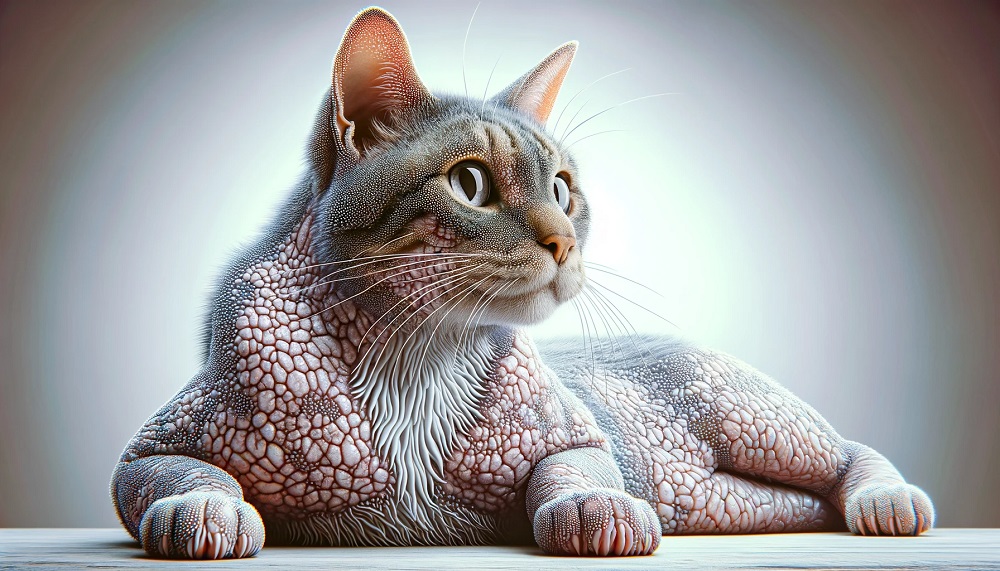
Scaly Skin on Cat
Cats are known for their sleek and elegant appearance, with their smooth fur being one of their most distinctive features. However, just like humans, cats can also experience various skin issues, including scaling. Scaling in cats refers to the presence of flakes or peeling skin, which can be both uncomfortable for the cat and concerning for the owner. Understanding the causes of scaling in cats is essential to ensure your feline friend’s health and well-being. In this article, we will explore some common reasons behind scaling in cats.
Causes of Scaly Skin on Cat
1. Dry Skin
One of the most common causes of scaling in cats is dry skin. Cats’ skin can become dry due to a variety of factors, including low humidity levels in the environment, bathing too frequently, or using harsh shampoos. Dry skin can lead to itching and scratching, which, in turn, can result in scaling as the cat tries to alleviate the discomfort by scratching the affected areas.
2. Allergies
Cats can develop allergies to a wide range of substances, including certain foods, environmental allergens like pollen or dust mites, and even specific grooming products. Allergic reactions can manifest as skin problems, including scaling, redness, and inflammation. Identifying and addressing the underlying allergen is crucial to managing scaling caused by allergies.
3. Parasites
External parasites such as fleas and mites can infest a cat’s skin, leading to scaling and other skin issues. These tiny creatures can cause intense itching and irritation, prompting the cat to scratch excessively. Regular flea prevention and prompt treatment for parasitic infestations are essential for preventing scaling and maintaining your cat’s skin health.
4. Infections
Bacterial or fungal infections can also be responsible for scaling in cats. These infections can occur due to various reasons, including scratches or wounds that become infected or compromised immune system function. Infections often result in redness, inflammation, and scaling in the affected areas. Veterinary diagnosis and treatment are necessary to address these issues effectively.
5. Nutritional Imbalances
A well-balanced diet is crucial for a cat’s overall health, including the condition of their skin and coat. Inadequate nutrition or certain dietary deficiencies can lead to dry, flaky skin and scaling. Ensuring your cat receives a high-quality diet that meets their specific nutritional needs can help prevent skin issues.
6. Underlying Medical Conditions
Scaling can sometimes be a symptom of underlying medical conditions such as hormonal imbalances (e.g., thyroid problems), autoimmune diseases, or skin disorders like seborrhea. It’s essential to consult a veterinarian if you suspect that an underlying medical issue is causing your cat’s scaling, as proper diagnosis and treatment are crucial.
7. Environmental Factors
Harsh environmental conditions, such as exposure to extreme cold or excessive sun, can impact a cat’s skin health. Extreme temperatures and sunburn can lead to dryness and scaling, especially in cats with lighter-colored fur or those with thinner coats.
8. Stress
Stress can manifest in various ways in cats, including skin problems like scaling. Cats may develop stress-related skin issues due to changes in their environment, routine, or social interactions. Reducing stressors and providing a safe, comfortable environment can help alleviate these skin problems.
Symptoms of Scaly Skin in Cats
Scaly skin in cats can be caused by various underlying issues, and the symptoms may vary depending on the cause. Common causes of scaly skin in cats include allergies, fungal or bacterial infections, parasites, and skin disorders. Here are some common symptoms associated with scaly skin in cats:
- Dry, Flaky Skin
- Itching and Scratching
- Redness and Inflammation
- Hair Loss
- Sores and Lesions
- Change in Coat Condition
- Odor
Treatment of Scaly Skin in Cats
Treating scaly skin in cats requires identifying the underlying cause and addressing it appropriately. Here are some general steps to consider:
Address Underlying Causes:
- Allergies: If allergies are the cause, your vet may recommend dietary changes, hypoallergenic shampoos, antihistamines, or even allergy testing and immunotherapy.
- Parasites: If parasites like fleas or mites are to blame, your vet will prescribe appropriate treatments, such as flea preventatives or parasiticides (Puainta®).
- Infections: Bacterial or fungal infections can be treated with antibiotics or antifungal medications as prescribed by your vet.
- Nutritional Deficiencies: Ensure your cat is on a balanced diet with high-quality cat food. Your vet can provide dietary recommendations or supplements if necessary.
- Dry Skin: Sometimes, scaly skin is caused by dryness. Ensure your cat is adequately hydrated, and your vet may recommend moisturizing shampoos or supplements like fish oil.
- Topical Treatments: Depending on the specific condition, your veterinarian may recommend topical treatments such as medicated shampoos, creams, or ointments. Follow your vet’s instructions carefully when applying these products.
- Bathing: If your vet recommends regular baths, use a gentle, hypoallergenic shampoo designed for cats. Be cautious not to overbathe your cat, as frequent bathing can strip the skin of essential oils and worsen dryness.
Related: Home Remedies for Cat Scabs
If you notice scaling on your cat’s skin, it’s essential to address the issue promptly. Mild cases of scaling may improve with gentle grooming and moisturizing, while more severe or persistent cases should be examined by a veterinarian. Identifying the underlying cause of the scaling is crucial for effective treatment and ensuring your cat’s comfort and well-being. Regular grooming, a balanced diet, and a stress-free environment can go a long way in preventing scaling and keeping your feline companion’s skin healthy and vibrant.






